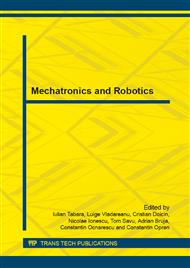[1]
F. V. Kovacs, C. V. Pau, Introducere in Robotica / Introduction to Robotics, Printech Publishing House, Bucharest, (2000).
Google Scholar
[2]
J. -P. Merlet, Parallel Robots, second ed., Springer, Dordrecht, (2006).
Google Scholar
[3]
K. A. Arrouk, B. C. Bouzgarrou, G. Gogu, CAD Based Geometric Procedures for Workspace and Singularity Determination of the 3-RPR Parallel Manipulator, Applied Mechanics and Materials 162 (2012) 131-140.
DOI: 10.4028/www.scientific.net/amm.162.131
Google Scholar
[4]
D. Pisla, N. Plitea, C. Vaida, Kinematic Modeling and Workspace Generation for a New Parallel Robot Used in Minimally Invasive Surgery, in: J. Lenarcic, P. Wenger (Eds. ), Advances in Robot Kinematics: Analysis and Design, Springer Science+Business Media B.V., 2008, pp.459-468.
DOI: 10.1007/978-1-4020-8600-7_48
Google Scholar
[5]
A. Csiszar, C. Brisan, Workspace Analysis of the 6 Degrees of Freedom PARTNER Parallel Robot, Solid State Phenomena 166-167 (2010) 155-160.
DOI: 10.4028/www.scientific.net/ssp.166-167.155
Google Scholar
[6]
C. Miclosina, Contributions to Analysis and Synthesis of Parallel Topology Robots Mechanisms, Using the Notion of Connexion", Doctor Thesis, "Politehnica, University of Timisoara, (2006).
Google Scholar
[7]
C. Miclosina, I. Vela, S. Ianici S., Workspace of a FP3+6×STS+MP3 Type Parallel Topology Robotic Guiding Device, in: Proceedings of Robotica 2006, The 3rd International Conference on Robotics, Iasi, Vol. II, 2006, pp.67-72.
Google Scholar
[8]
Fr. Kovacs, C. Miclosina, Metoda de determinare a spatiului de lucru utilizand notiunea de Perechi de Sisteme de Referinta" (PeSiR) / Method of Workspace Determination Using the Notion of "Pair of Frames, (PF), Robotica & Management Vol. 7 No. 2 (2002).
Google Scholar
[9]
C. Miclosina, Metoda de determinare a spatiului de lucru al robotilor cu mecanismele dispozitivelor de ghidare avand topologie paralela, utilizand notiunea de Perechi de Sisteme de Referinta" (PeSiR)/ Method of Workspace Determination of Robots with Guiding Device Mechanisms having Parallel Topology, Using the Notion of "Pair of Frames, (PF), Robotica & Management Vol. 8 No. 1 (2003).
Google Scholar
[10]
M. Ceccarelli, M. Sorli, The Effects of Design Parameters on the Workspace of a Turin Parallel Robot, Int. J. of Robotics Research 17(8) (1998) 886–902.
DOI: 10.1177/027836499801700806
Google Scholar
[11]
L. Chen, B. Cui, Analysis of the Influence of Structure Parameters of Six Degree of Freedom Parallel Robot Workspace, Advanced Materials Research 933 (2014) 390-394.
DOI: 10.4028/www.scientific.net/amr.933.390
Google Scholar
[12]
F. V. Kovacs, C. Miclosina, Geometrical, Kinematical and Kinetostatical Modelling of a PFx3+6xSTS+PMo3 (MSSM) Type Parallel Topology Robotic Guiding Device with Rigid Links, Using the Concept Pair of Frames, (PF), in: Proceedings of the 2nd International Conference on Robotics, Timisoara-Resita, Intergraf Publishing House, Resita, 2004, pp.99-100.
Google Scholar
[13]
C. Miclosina, Geometrical (Degree 0) Modelling of a FP3+6×STS+MP3 Type Parallel Topology Robotic Guiding Device, Using the Connexion" and "Pair Of Frames, Concepts, in: Proceedings of Robotica 2006, The 3rd International Conference on Robotics, Iasi, Vol. II, 2006, pp.59-66.
Google Scholar
[14]
Information on http: /help. solidworks. com.
Google Scholar


